There are quite a few individuals who are interested in learning how to navigate the magnificent starry sky. However, for beginners, the night sky can appear chaotic, yet undeniably stunning. It may seem impossible to comprehend the complexity of the celestial bodies.
For many, the idea of meticulously studying the starry sky with a map can be discouraging. On the other hand, having the ability to navigate among the stars forms the foundation for practical observations. How does one locate Jupiter or Saturn in the night sky? Where can the variable star g Hercules be found? And how does one pinpoint the location of the globular cluster M3? For those who possess a basic understanding of the positions of celestial bodies and have access to a starry sky atlas, answering these questions is relatively straightforward.
The primary principle in studying any subject is a gradual progression from simplicity to complexity. This principle is especially applicable to practical astronomy. If you wish to develop your ability to navigate the night sky, it is best to start with small steps: first, commit to memory the brightest stars that are visible in the evening and the most prominent star patterns, which are known as constellations or asterisms. Once you have become proficient in distinguishing between stars such as Vega and Deneb, as well as identifying the constellations of Cygnus and Aquila, you will be equipped to locate and memorize smaller and less conspicuous star patterns using these initial constellations and stars as guides.
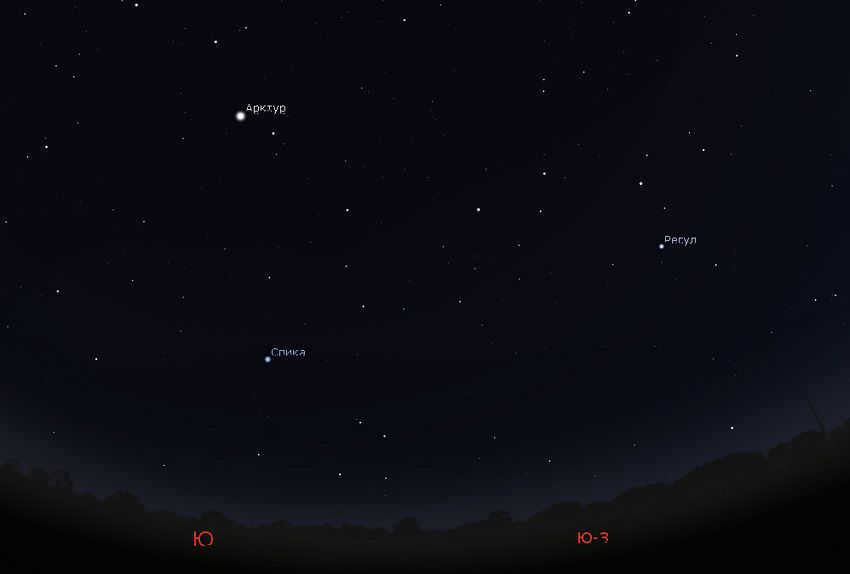
Regulus, Spica, and Arcturus are the three primary stars that shine brightly in the sky during the spring season. This stunning display can be observed using Stellarium, a popular stargazing application.
The star Regulus and the Leo constellation
Regulus is the leading star in the constellation Leo, which is easily identifiable by its distinctive trapezoidal shape formed by four prominent stars. Additionally, the Leo constellation features the asterism known as the Sickle, which represents the head and chest of a mythical predator. Regulus is situated at the lower right corner of the Lion’s Trapezium, marking a significant point within the constellation. As the spring season begins, the Leo constellation is visible in the eastern sky during the evenings. Towards the end of spring, as dusk sets in, the constellation can be spotted in the southwestern direction.
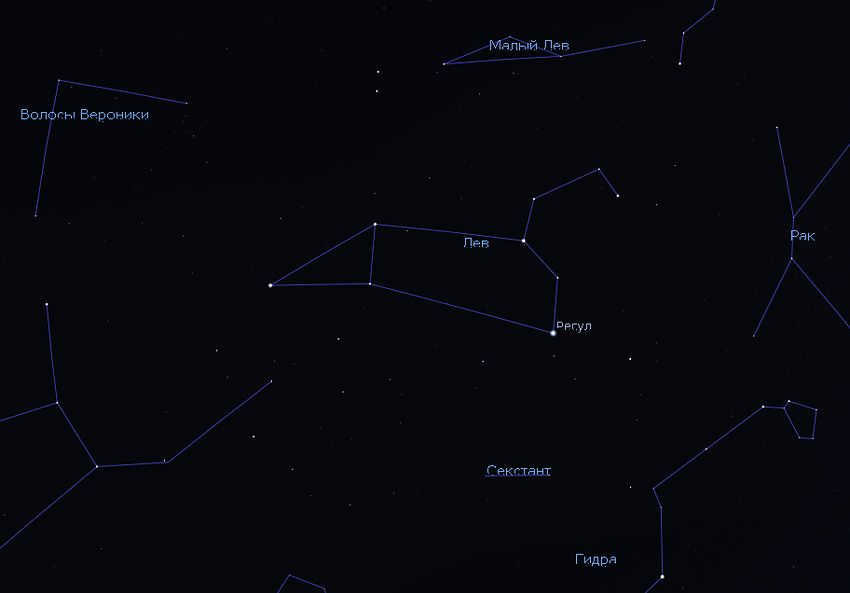
The constellation Leo can be easily identified by its distinctive shape, resembling the body and head of a celestial predator. This unique figure can be observed in the night sky, as depicted in the image above.
In addition to the figure of Leo, there are two other prominent stars in the eastern region of the constellation. These stars, known as Arcturus and Spica, can be seen in the southern part of the sky during the latter half of spring.
Arcturus, in particular, stands out as the brightest star in the northern celestial hemisphere. Its reddish color and prominent position make it easily recognizable, especially during the months of April and May. As you observe Arcturus, you may notice a chain of stars extending to the left and upward, forming the pattern of the constellation Boötes. Some liken this pattern to a large letter “P,” while others see it as a parachute with Arcturus as the parachutist at its base.
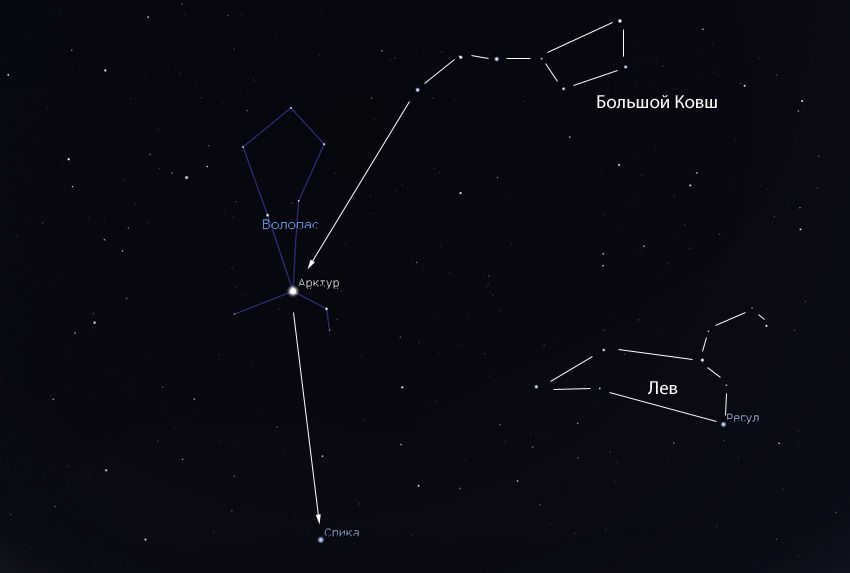
You can locate Arcturus and Spica by starting from the stars of the Ursa Major constellation. Picture: Stellarium
Although Arcturus is a very bright star and easily noticeable in the spring sky with few stars, here’s another method to locate it. Look up at the zenith in the evening. Directly above you, you will spot the well-known Ursa Major constellation. (If you are facing north, the constellation will appear upside down – the bottom of the constellation will be facing south!) Now, mentally draw a line connecting the two outermost stars of the constellation’s handle. Extend this line, slightly curved, about 30 degrees to the south. The line will lead you to Arcturus!
If we continue to extend this line further south, we will reach the third most luminous star in the spring sky, which is Spica.
Spica and the constellation Virgo.
Spica serves as the primary star in the expansive yet not particularly distinctive constellation Virgo. The most notable pattern of Virgo is an irregular quadrilateral, with Spica occupying the lower corner. This zodiacal constellation spans across both sides of the celestial equator, but does not contain any stars that are brighter than 3rd magnitude (except for Spica itself). Therefore, in a large city, the outlines of this constellation are often not visible due to the presence of street lighting.
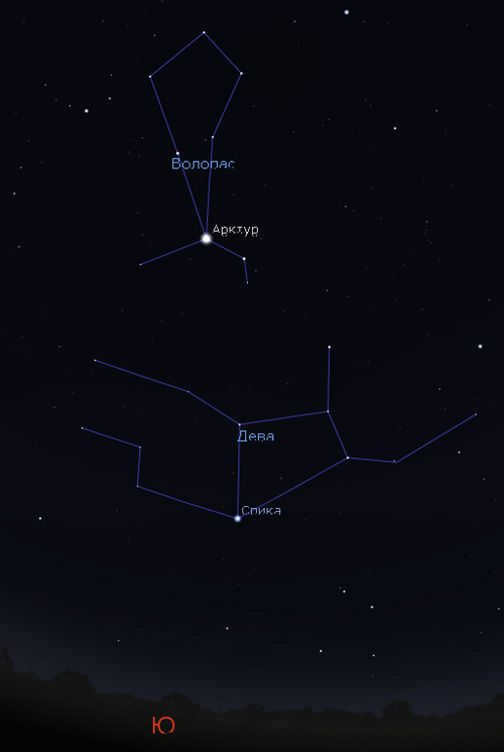
The constellations Volopassus and Virgo can be seen in the spring sky. This image was captured using Stellarium software, which provides a realistic view of the night sky.
When the ecliptic passes through the constellation Virgo, it often becomes a temporary home for the Moon and planets. In 2017, for example, the planet Jupiter could be seen near the bright star Spica. Jupiter’s brightness is so intense that it outshines the brilliance of any other star in the vicinity. Beginners may sometimes mistake planets for stars, but if you are familiar with the brightest stars and the patterns of the main constellations visible during a specific time of year, you will be able to distinguish between them. Planets have a different appearance and movement compared to stars, which will help you identify them easily.
So, we’ve become acquainted (yet again!) with the three primary constellations of spring – Leo, Volopassus, and Virgo. When we refer to them as “spring constellations,” we mean that they are highest above the horizon, in the south, during spring evenings. However, this doesn’t imply that they cannot be seen at other times of the year! Nor does it imply that they will be visible, for example, in the pre-morning sky in May. During that time, the southern part of the sky will be occupied by the constellations of summer. But we will focus on those next time.
In the moonless night sky in March and April, the Leo constellation is highly visible. It is situated near the constellations of Cancer, Virgo, Virgo Bowl, Leo Minor, and Sextant.
On a clear spring night, even without the aid of a telescope, one can observe up to seventy stars in the Leo constellation with the naked eye. Although most of the stars in this constellation are relatively small and not very luminous, it is adorned by two prominent and exquisite stars. These stars are Regulus, a brilliant bluish-white star with a magnitude of one, and Denebola, a second magnitude star.

A breakdown of the presentation by individual slides:

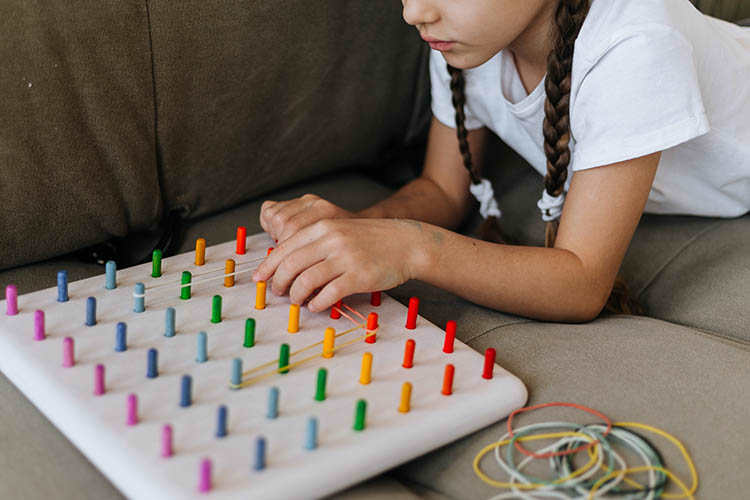

What is your knowledge about stars and the Sun?


Indeed, every star represents a massive glowing sphere. The sun, in particular, is classified as a star.
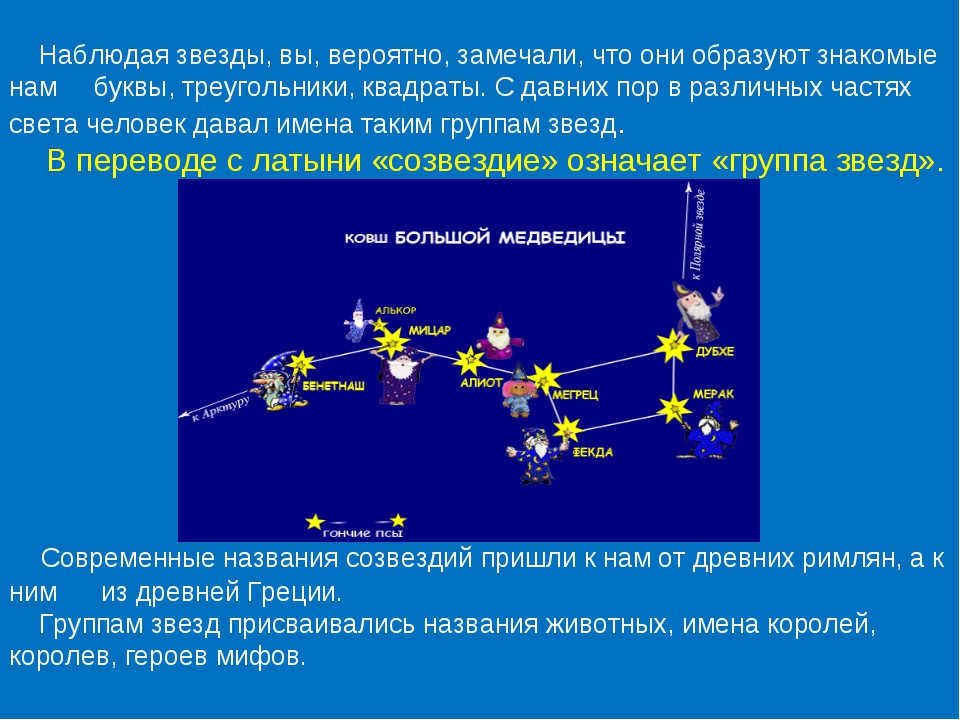
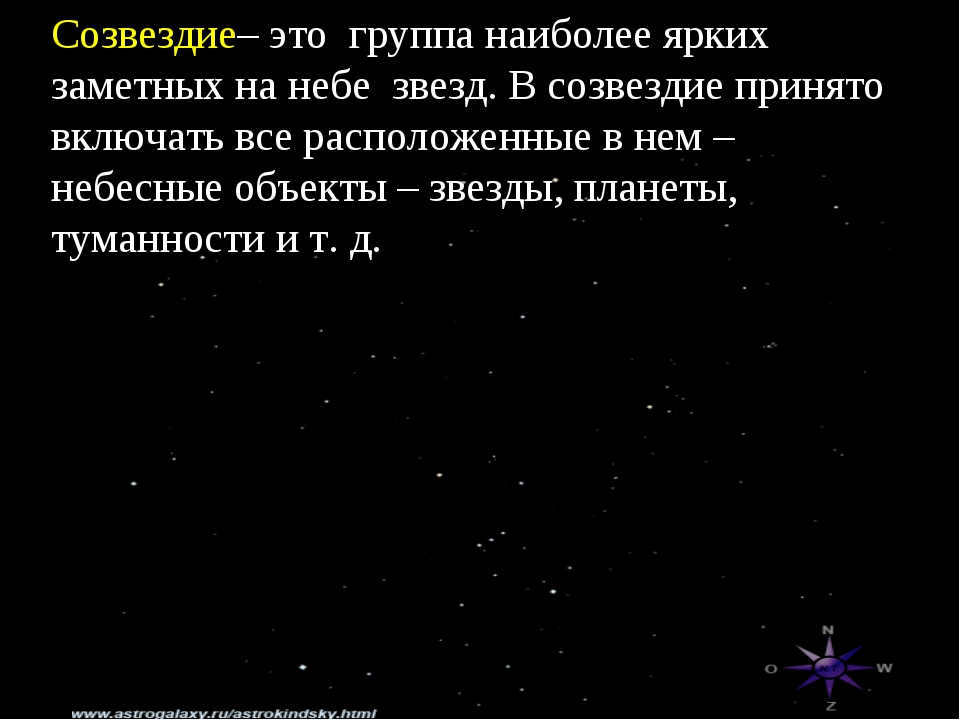
A constellation is a cluster of the most luminous stars that can be observed in the celestial sphere. Typically, a constellation encompasses all astral entities situated within its confines, such as stars, planets, nebulae, and so on.
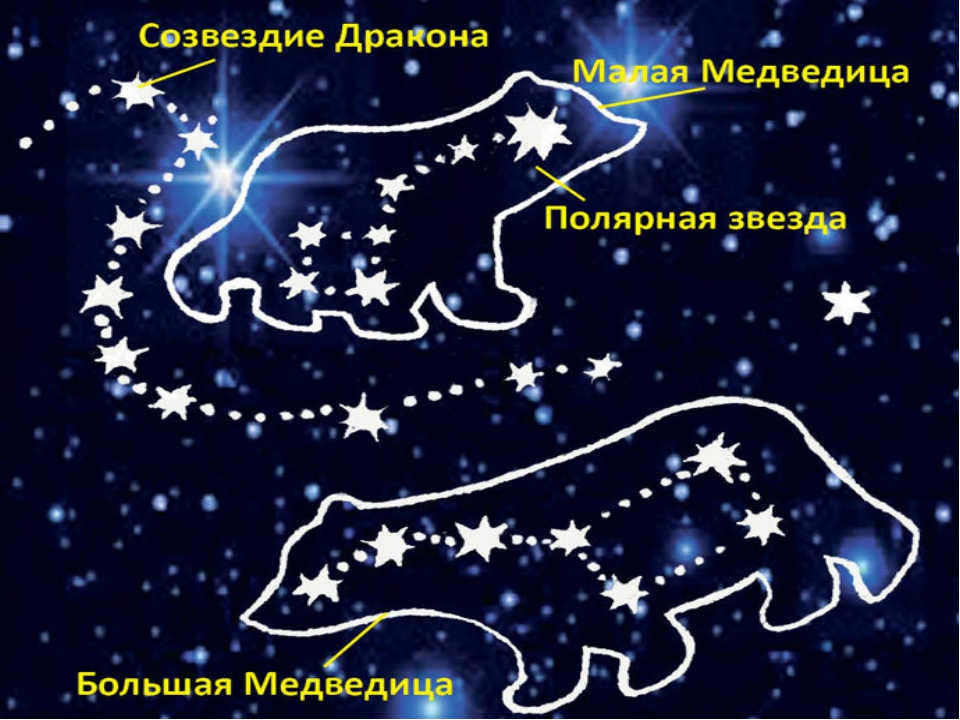
The Dragon has a nearby resident. He is cantankerous and prefers to stay at home. His house is slightly crooked, but it is solid. ♪ It lacks windows and doors ♪ ♪ And inside resides the ruler of Cepheus, known as King “W” ♪ [Close to Cepheus is the term “woman” in the English language. That is the wife of King Cepheus, the esteemed CASSIOPEIA.
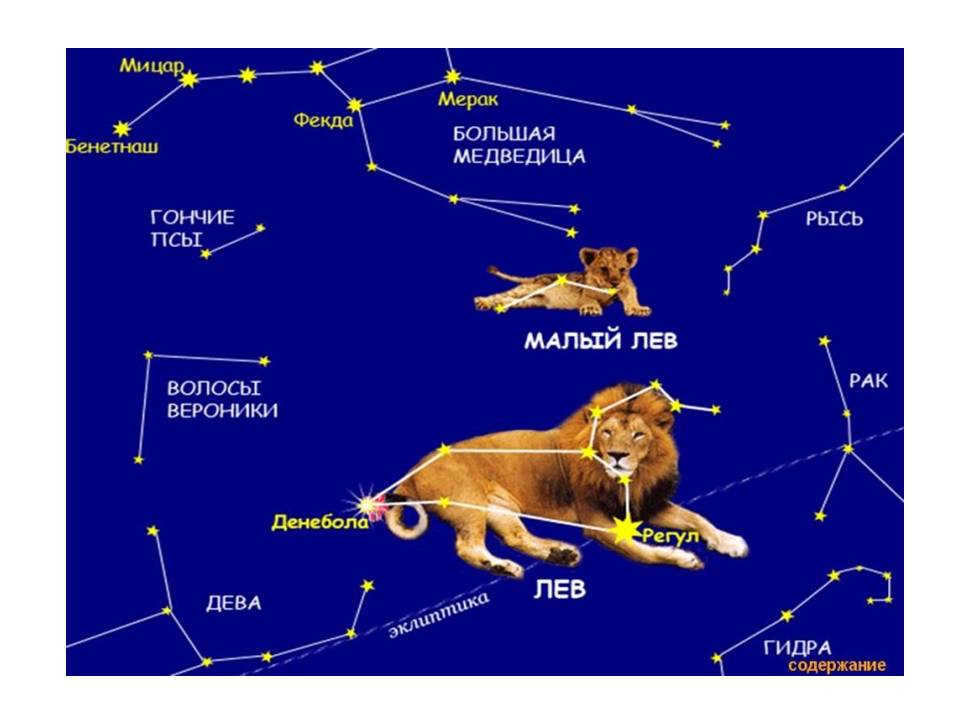
1) What exactly is the zodiac? 2) Approximately how many constellations do you estimate are in the zodiac? 2) How much time does the Sun spend in each individual constellation? 3) In which specific constellation is it traditional to start a journey through the zodiac?
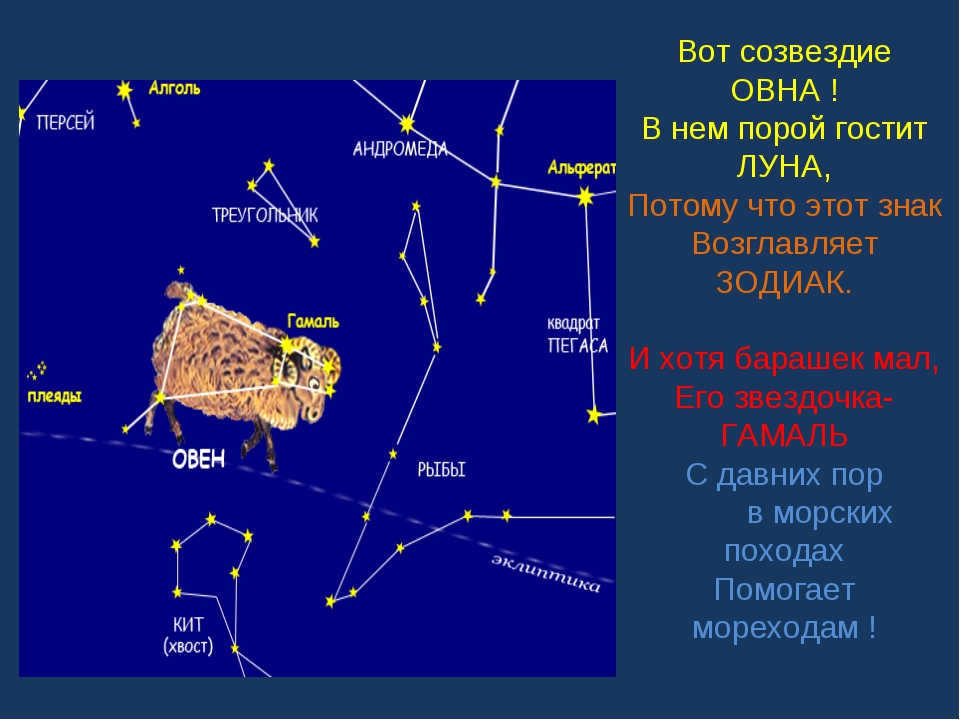
Behold the constellation of Aries! From time to time, the Moon pays a visit to this celestial formation as it represents one of the twelve signs of the Zodiac. Despite its small size, one of its stars, GAMAL, has been guiding sailors on their sea voyages for countless years!
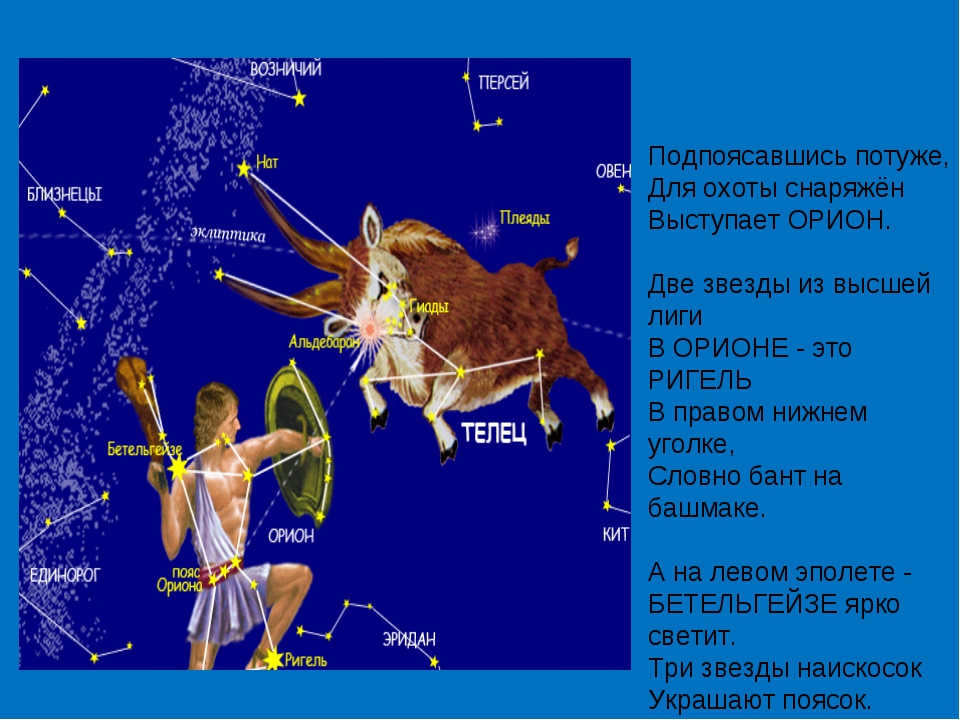

There are two stars belonging to the highest league in the ORION constellation. One of them is RIGUEL, located in the lower right corner, resembling a bow on a shoe. On the left epaulet, there is a bright shining star called BETHELGEISE. The sash is adorned with three stars placed at an angle.
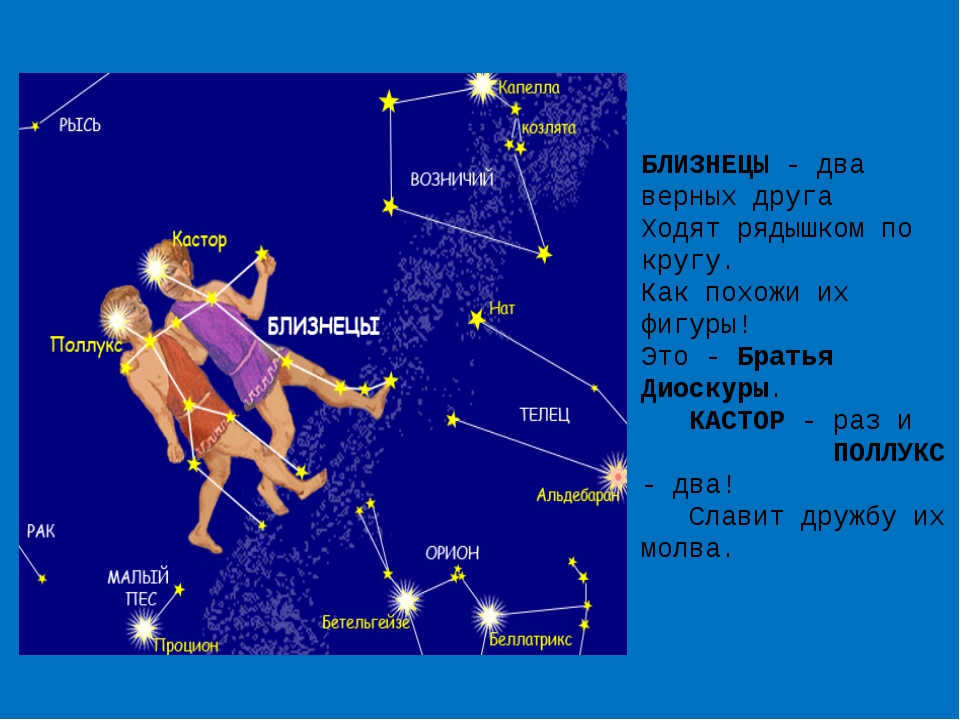

The two faithful friends stroll side by side in a circular path. How similar are their forms! They are the Dioscurus Brothers. CASTOR one and POLLUX two! Their friendship is admired by the entire world.
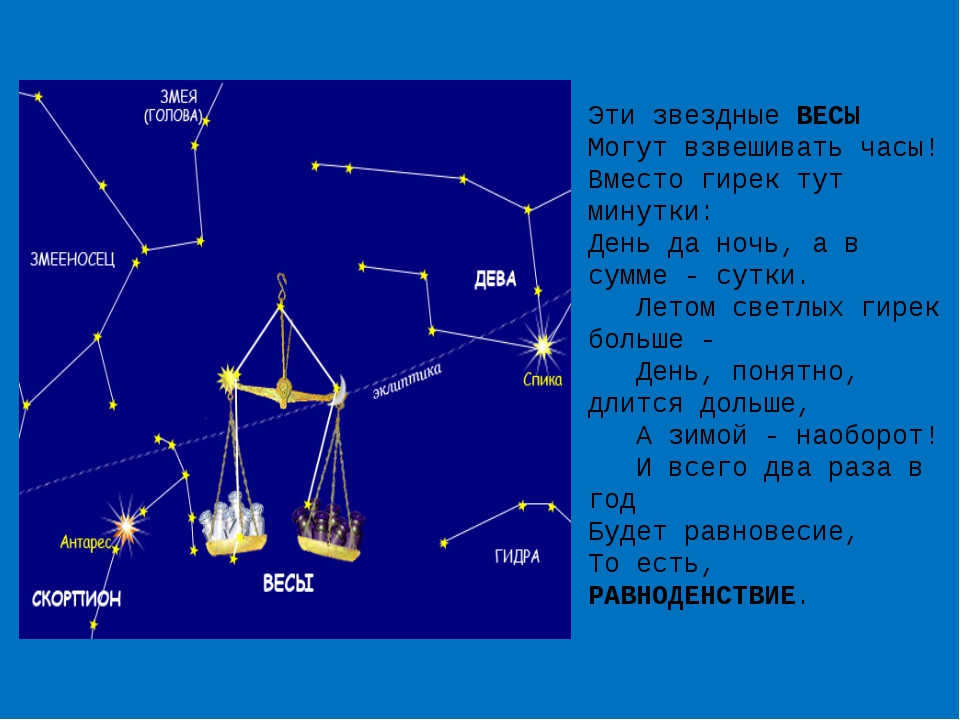
These celestial Scales have the ability to measure time! Instead of traditional weights, they use minutes: Day and night, which together make up a full day. During the summer months, the day carries more weight as it lasts longer, while in winter, it is the opposite! And only twice a year, there is perfect balance, or EQUALITY.


For homework, please complete the following tasks: 1) Familiarize yourself with the myth behind one of the constellations (be ready to share the story); 2) Workbook p.39, exercises 3 and 4. Best of luck with your studies.
Continuing education program
The modern format of teaching: distance learning

Advanced Training Program
Identifying and remedying neuropsychological challenges such as dyslexia, dysgraphia, and dyscalculia in elementary school students.

Advanced training program
Current issues in the theory and methodology of teaching at the elementary school level in accordance with the FSES LEO.
Online courses for educators
Get a certificate and a discount on training for every participant
Discover resources for any lesson by specifying your subject (category), grade level, textbook, and topic:
Over 5,605,619 materials available in the database
The most popular international online learning courses
School Info Competitions 2022
Get a certificate and a tuition discount for every participant
Additional Resources
These courses might also be of interest:
Share Your Thoughts
- Date: 23.03.2016
- File Size: PPTX 2.9 MB
- Total Downloads: 354
- Rating: 4 out of 5
- Please rate this material:
Author of the Material
Moscow Institute of Professional
Retraining and Advanced Training
for Teachers
Distance learning courses
for educators
We provide official documentation
in accordance with established standards!
Educators share their secrets of successful preparation for the USE exam
New courses: functional literacy, FSES LEO, inclusive education, and more
Schools in the Crimean districts bordering Ukraine will start their vacation earlier than planned
Students from Russian universities will have the opportunity to receive 1 million rubles to launch their own startups
10 thousand children from the Luhansk and Donetsk People’s Republics have arrived in Russia
Kursk authorities have transitioned students in border districts to distance learning due to the situation in Ukraine
The Russian Ministry of Education is preparing teachers to educate children from the Donbass region
Gift vouchers
The responsibility for resolving any conflicts regarding the materials and their content lies with the individuals who have uploaded the materials on the website. Nevertheless, the site’s administration is prepared to offer full assistance in resolving any matters concerning the site’s operation and content. If you come across any instances of unauthorized material usage on this site, kindly notify the site’s administration through the provided feedback form.
All content published on this website is either created by the website’s authors or submitted by its users, and is provided solely for informational purposes. The copyrights for the materials belong to their respective authors. Any unauthorized reproduction or distribution of the website’s content, in whole or in part, is strictly prohibited without the written consent of the website’s administration. The views expressed by the administration may not necessarily reflect those of the authors.
The Great Bucket will be visible directly above from the northern latitudes. Trace a line from the handle to Arcturus (the yellow star in Volopassus). The arrangement of stars in this constellation is reminiscent of a kite, with Arcturus serving as the base. Continue along this path and you will come across Spica (a blue-white star in Virgo).
Directly below and to the right of Spica, you will find a cluster of four bright stars that resemble a sail. This cluster is known as the Raven constellation. It’s truly awe-inspiring to witness the grandeur of this constellation, despite its diminutive size.
The sky at night is filled with a multitude of stars. It is not possible to observe every single star without the aid of optical instruments, as dim celestial bodies often go unnoticed. Using astronomical instruments, scientists have been able to record over 3000 stars in the visible portion of the sky, with twice as many stars being visible in both the northern and southern hemispheres. The ancient Greek sailors would navigate their ships by using the patterns of stars in the night sky, and descriptions of certain constellations can be traced back as early as the 4th century BC.
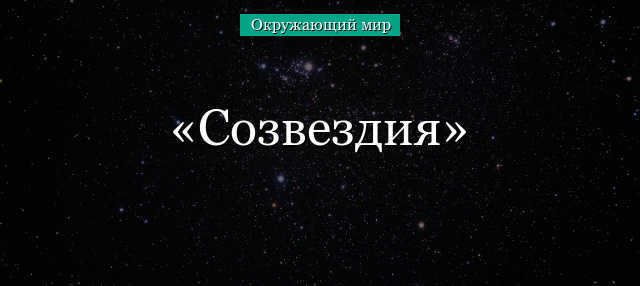
Understanding Constellations
Constellations refer to clusters of stars that appear to be close to one another when observed from Earth. Astronomers have divided the entire celestial sphere into different sections, with each section containing stars that are grouped together to form a constellation. During the Congress of Astronomers in 1922, the boundaries of the 88 constellations were officially established.
Although the distances between the different sections of constellations can be vast, they are still considered part of the same group and are often included in the constellation’s narrative.
Within the Virgo constellation, there exists an aggregation of over 2,500 galaxies. The luminous rays emitted from these galaxies travel for a staggering 1.3 billion years before reaching the Earth. Consequently, astronomers are granted a remarkable glimpse into the remote history of the universe.
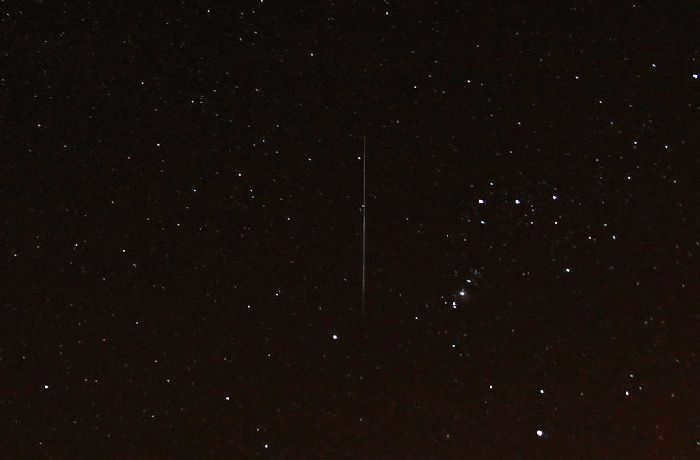
Constellations in Ancient Times
During ancient times, individuals would connect the most luminous stars by drawing lines and creating depictions of mythical creatures, deities, and even musical instruments. Scholars would also create maps of the celestial heavens.
Those passionate about astronomy are likely acquainted with Jan Hevelius’s star atlas, which features conventional representations of constellations (1687).
Notes on the same topic:
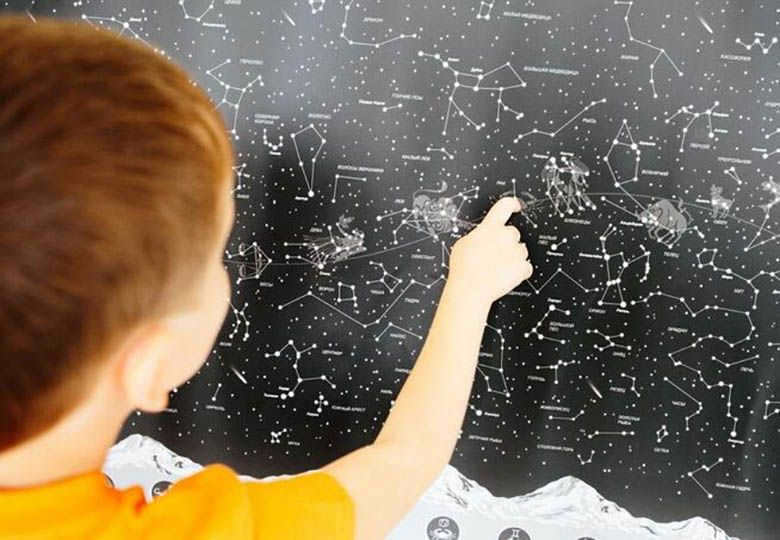
Astronomers use the starry sky as a guide, much like a map. To make it easier, they have divided all the bright stars into constellations. Currently, there are 88 known constellations, but there are countless more stars in the universe that we can’t even begin to count! In this article, you will discover exciting games that will help children learn about constellations. Additionally, there are active and entertaining relay races that are themed around the stars.
For an audio version of this article, click here: Games for learning constellations for children
Discover a constellation
Explore constellations with this easy game. An adult marks the main stars of the constellation with bright dots on a square piece of paper using a marker, and the child connects them with lines.
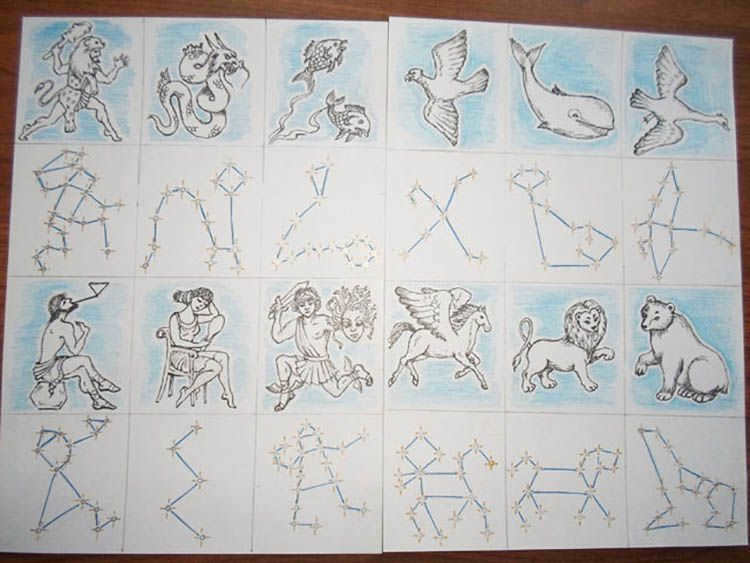
Instead of using dots, you can opt to use small star-shaped stickers to depict the constellations. This will make it easier to understand and follow. In case the constellation is complex, you can number the stickers and draw lines connecting them in a sequence. Encourage the child to use a ruler to draw the lines accurately. Make sure to give each drawn constellation a name and explain how it acquired its name.
Constructing the constellations is also an option, apart from drawing them. The simplest method is to use matches and plasticine.
If the matches are too short, you can use wooden skewers or toothpicks instead. Here’s a more creative idea: create edible constellations using straws. You can connect them together using marshmallow marshmallows.
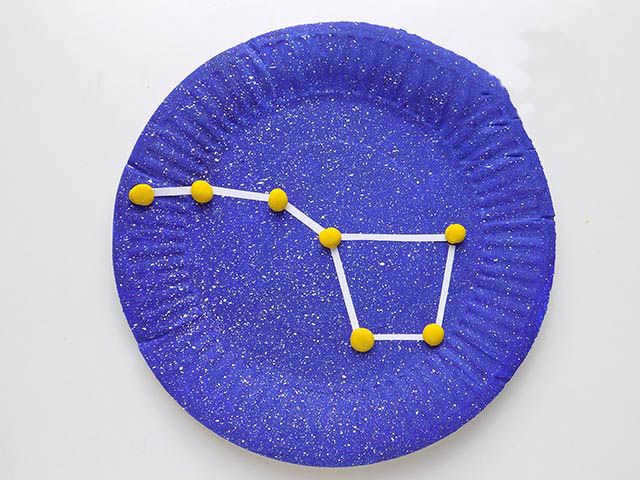
Constellation Collection
Engage in a team game with two participants on each team. Each team is assigned a different color, such as blue and red. Scatter red and blue cardboard stars on the floor, resembling a starry sky. The participants from each team are blindfolded.
The task for the players is not easy – they must collect a bouquet of stars, but only those that are colored with their team’s color. How can they find the stars with their eyes closed? The other team members will help! The players need to carefully listen to the clues, such as “right, left, take this one, don’t take that one,” and so on. After two minutes, the game ends, and the participants show their star bouquets. The team with the most stars of their color wins.
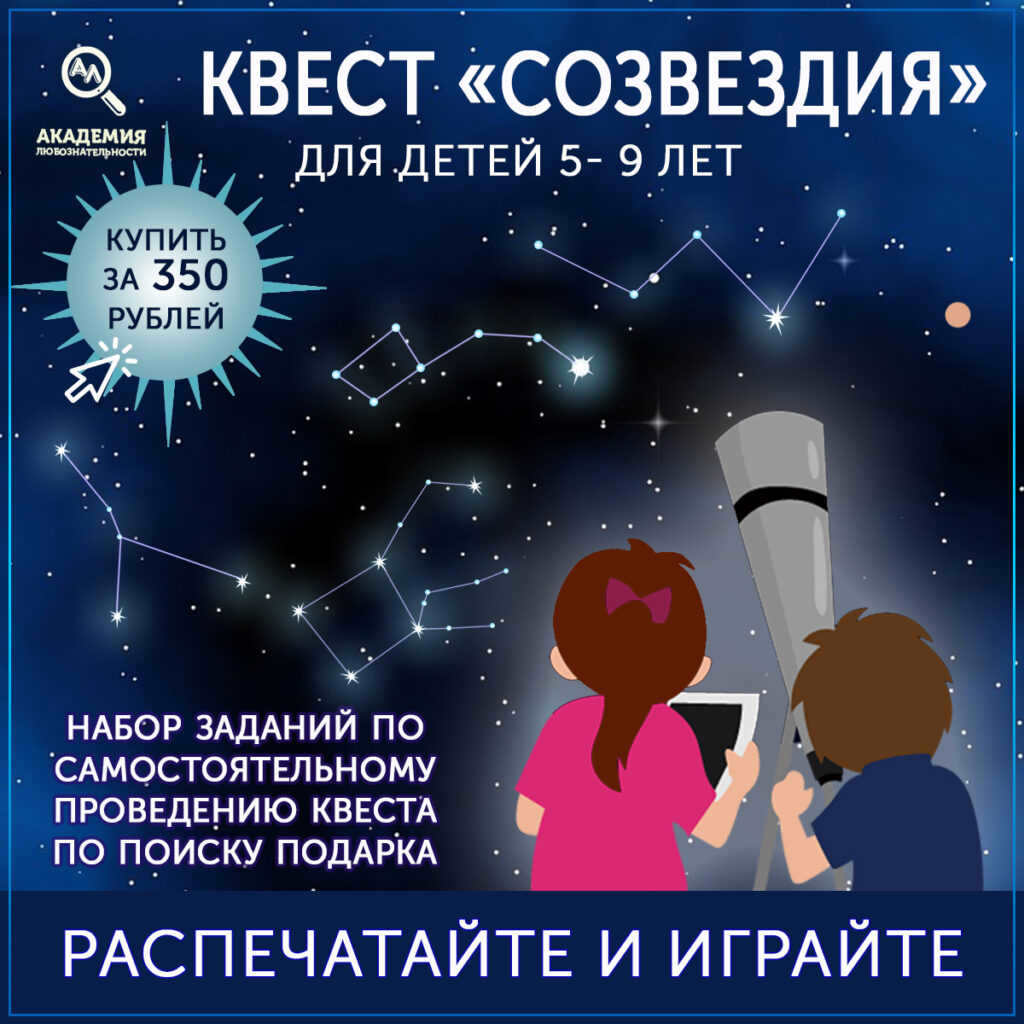
Astronomical geoboard
An astronomical geoboard is a device consisting of a board with nails that are used to stretch colored rubber bands. The arrangement of the rubber bands and nails on the geoboard mirrors the segments and stars found in constellations. While there are pre-made astronomical geoboards available for purchase, it is also possible to create one with your own materials.
To create the base of the geoboard, you will need foam plastic and a printed image of the night sky. Glue the image onto the foam plastic to serve as the backdrop. For the “stars” on the geoboard, you can use stationery buttons with large colored caps, as they provide a secure attachment for the rubber bands.
There are several ways to play with the astronomical geoboard:
- One way is to insert the anchor points of a constellation onto the geoboard and have the child connect the dots with the rubber bands, while also naming the constellation.
- Another way is to verbally provide the name of a constellation and have the child construct it themselves, using the arrangement of the “stars” on the geoboard to draw the lines.
- You place the stars of multiple constellations onto the geoboard, and your child must identify them in the night sky and connect the dots with lines on their own.
The Milky Way
You can either play individually with your child or in pairs. In the former scenario, we focus on developing balance, speed, and jumping abilities. In the latter scenario, it becomes a race to see who can reach the finish line first.
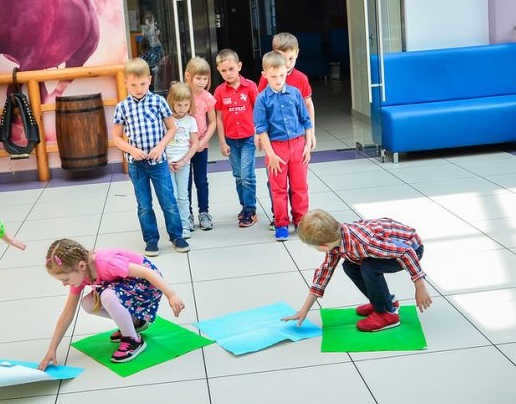
One team member is in possession of two large cardboard stars and arranges them in a pathway, representing the Milky Way. The objective is for the second team member to navigate the pathway, stepping solely on the stars.
The outcome of the game will be determined by both speed and the distance between the stars, which determines the length of the astronaut’s jumps. Naturally, the first person to successfully traverse the Milky Way without stumbling will be declared the winner.
To get ready for the game, you will require a telescope. You can easily create one using a circular Pringles chip container. Simply remove the bottom of the can and, near one of the edges, create a small aperture. This will serve as the eyepiece.

Get two sets of the constellation cards printed. You can get the cards by downloading them here. On one set, round one edge of each card so that it fits into the telescope. Then, using a needle, make holes on the stars of the constellations on these cards.
Here’s how the game works: Place half of the constellations on the table, and insert their matching pairs into the telescope one by one, and close the lid. The child should look through the telescope’s eyepiece at the light, remember the constellation, and then find the same constellation on the table.
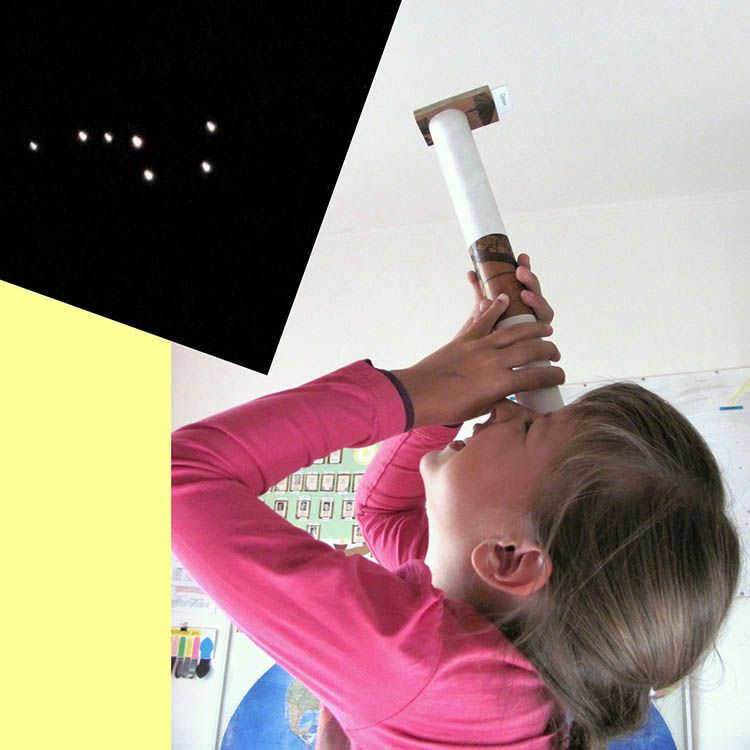
When working with older children, it’s important to provide them with the names of these constellations.
Big and Small Stars
This is a traditional attention game that can be played as a physical activity in between sedentary games. It can also serve as a reminder to children that stars come in different sizes, either as giants or dwarfs. In the standard version, the game leader divides the children into two teams:

The teams can be mixed up, not necessarily in order, to add variety for the children.
For older kids, you can make the game more challenging by introducing additional activities. All stars can be categorized based on their surface temperature, which is represented by their color. Blue stars are the hottest, followed by white, yellow, and red stars, which are the coolest. You can incorporate the star’s color and corresponding movements into the warm-up:
- Blue – wave your hands in front of you to represent heat.
- White – cover your eyes with your palms as if the star is shining too brightly.
- Yellow – show the “class” and warmth with both hands, similar to our Sun.

- Now kids can easily get bewildered. For instance, with the instruction “White Giant,” children must stand up and shield their eyes with their hands. Additionally, from time to time, you could announce “A supernova has ignited!” at which point all the children should leap up as if caught in a shockwave.
Recollections
This pastime is an excellent method to enhance memory and focus. Get the star group cards by clicking on the link provided and print out two copies.
Mix up the cards and place them face down on the table. To begin, you can start with 5-7 pairs depending on the age of the players, and then increase the number of cards. This game can be played with either one child or a group of children. If playing with a group, lay out more cards right away.
The player must uncover any two cards. If they reveal the same star group, they collect them and uncover the next two cards. If not, the player must remember the location of those star groups and turn the cards back over. When playing with a group of children, the turn is passed to the next player. The participant who collects the most star groups is the winner.
Stargazer Magicians
Each day, fresh stars emerge in the cosmos. Who ignites them? Perhaps the youthful stargazer magicians? Today, we face a challenging task – adorning the sky with novel constellations.
You can engage in this activity alongside your child or a group of children. Regardless, there must be two teams, regardless of the number of participants. For the competition, stargazers will require the following materials:
- Two wattmans affixed to the wall. The paper should be colored in a deep shade of blue – representing the night sky.
- Stars made from cardboard of varying sizes.
- Modeling clay.
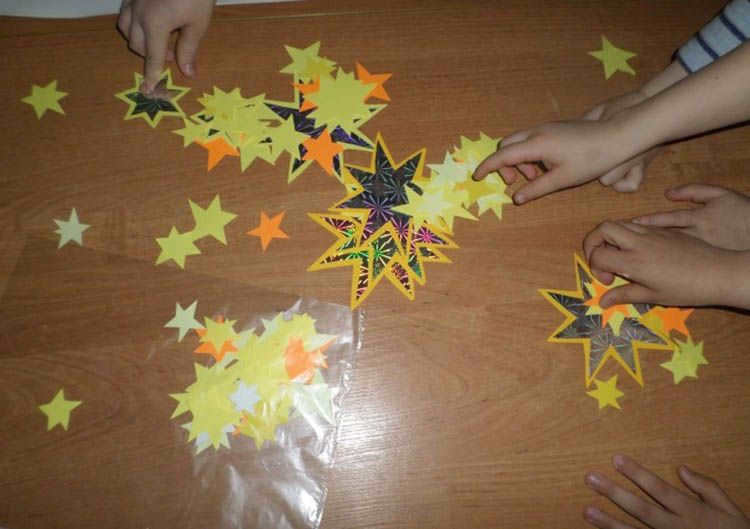
If you are playing with a child, both of you can attach the stars to the plasticine on your own paperboard. In case you are playing with a group of children, the team members can take turns approaching the paperboard, just like in a relay race.
The initial task is to stick the stars to the sky and create a constellation with them. After that, it is important to count how many new stars have appeared tonight.
The second task is to come up with a name for the new constellation. Sometimes it can be challenging to think of a name, so don’t hesitate to ask for help and use leading questions – what does the constellation look like? Is it resembling an animal or an object? What shape does it have?
Third task: replicate an actual constellation. Your objective is to arrange the stars on the sky in such a way that you recreate a real constellation, such as the Big Dipper or Cassiopeia.
Star Brush
Now let’s determine which team excels at painting. Prior to the activity, divide the constellation cards based on their complexity, taking into account the number of stars they contain (you can download the cards from the “Memori” game).

Players from both teams approach the whiteboard and grab brushes (pencils, markers) in their hands before selecting a card with constellations to draw. The team member who successfully draws the constellation first earns a point for their team. The process continues with the next set of participants.
Alternatively, players can compete by quickly molding plasticine constellations. The objective remains the same – participants must replicate the constellation depicted on the card.
One player selects a constellation to depict, while the other participants try to guess it. The person who correctly guesses the constellation then takes a turn to act it out.
When representing constellations, it is possible to use schematic gestures. For example, Sagittarius can be depicted by miming archery, Lyra by pretending to play a musical instrument, and Andromeda by raising one’s hands up in the air.
By the way, if the children have become familiar with the images of constellations, you can play a modified version of the game called “The Sky Waves Once”. Instead of freezing in a sea-related pose, players freeze in the shape of a constellation.
Map of constellations
Grab a sheet of paper, and sketch stars in various sizes and shapes (with elongated rays) to create a unique constellation. The more stars you incorporate into this constellation, the more challenging the task becomes.
Once you have finished sketching, carefully cut out all the stars using a utility knife. Then, proceed to color them in a vibrant yellow shade, while coloring the remaining paper surrounding the stars in a soothing blue hue.
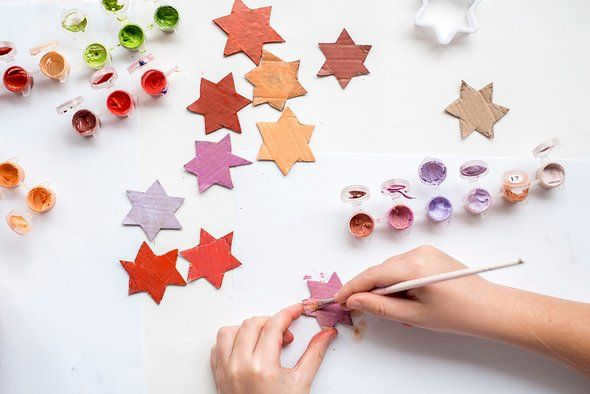
It is an easy task for the child – they need to connect all the stars to their corresponding positions and identify the resulting constellation. If there are multiple children participating, they can be divided into two teams for a competitive game. Each team should have a cotton pad with a constellation on it.
Shooting Stars
Split the children into two groups and organize a relay race. Alternatively, you can keep all the kids in one team and turn it into a game of navigating an obstacle course. Here’s what you’ll need to do:
- Create an obstacle course with 3-5 different elements. For instructions on how to make an obstacle course, refer to the article “DIY Obstacle Course for Children”.
- Place a jar at the end of the obstacle course, filled with blank cards and pictures of constellations.
- Position a basket or bag at the beginning of the obstacle course to hold the cards with constellations.

Stargazer, Grab a Falling Star
This activity is perfect for a big group of 8 individuals. The objective is to create two circles and place one designated stargazer in the middle, blindfolded. As the music starts, the participants dance around the stargazers, trying to catch the falling stars.

Once the music stops playing, the blindfolded individuals participating in the stargazing game attempt to catch one of the stars – a player from their circle. The stargazer who can determine with closed eyes who they have caught the fastest is declared the winner. The caught stars then switch places with the stargazers, and the game carries on.
Embracing celestial formations

Kids scamper around to the music, pretending to be shining stars. The emcee turns off the music and announces, “The stars have united as 2 (3,4) constellations”. The kids must quickly grab hands with the stars next to them to form a constellation. Anyone who is left without a partner is out of the game. In the end, the constellation of two stars emerges victorious. Just make sure to remind everyone that they can’t form pairs while the music is playing!
What is the game called?
Introducing a fun team game aimed at strengthening your familiarity with constellations. Create or obtain cards featuring constellations without any labels, you can download them here:
Split the children into two groups and set the constellation cards on the table. Members from each team take turns approaching the table, selecting one card, and identifying the constellation. If the correct name is provided, the player keeps the card, and the team earns a point. The team with the most accurate recollection of all the names emerges victorious.
Star Puzzles
Get the downloadable cut cards by clicking on the link provided and print them out. Cut each constellation along the lines that divide them. If you have just one child, challenge them to piece together the constellation like a puzzle and try to recall its name. If you’re playing as a team, you can suggest a fast-paced puzzle challenge. In this game, one member from each team will approach the table and gather a puzzle. The first member to bring back the completed puzzle will earn a point for their team. After that, the next members from each team can take their turn.
Discoveries with the Telescope
Let’s start by creating a mesmerizing night sky, here’s what we’ll need:
- A glass plate or a transparent baking dish with a level bottom.
- Black watercolor paint.
- Sparkles.
- Water.
- A sheet of paper and a marker pen.
- A clear glass beaker or jar.
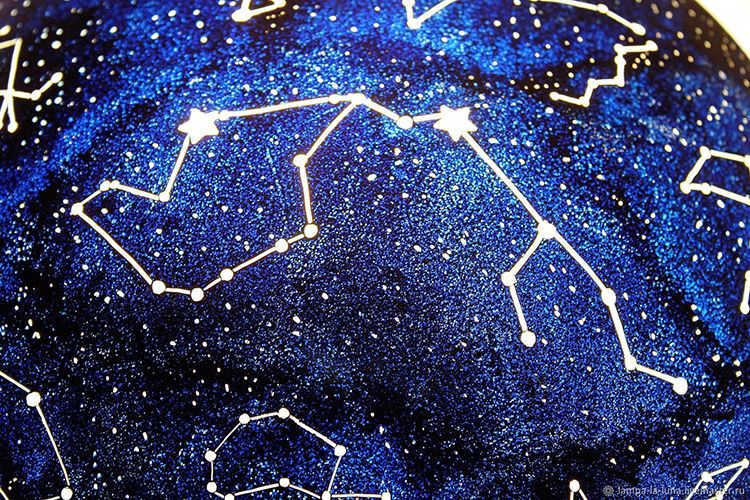
Using a marker, we outline the plate’s circumference on the bottom, then cut out a circle along the outline. Next, we draw constellations on a piece of paper. We attach the paper circle to the back of the glassware using tape.
We pour a small amount of water and black gouache into the plate, then mix them together. After that, we sprinkle glitter on top. This creates a starry sky, obscuring the bottom of the plate from view.
The child grasps a glass with their hands and places it upside down on the plate – transforming it into a telescope. If the glass is balanced, the air trapped inside will prevent the colored water from seeping in. Challenge the child to glide the glass across the plate’s surface without lifting it. Interestingly, the telescope allows you to observe the bottom of the glass, revealing constellations beyond. Encourage the young astronomer to identify and name these constellations.
As night falls, the sky darkens, and stars emerge.
This vast celestial realm is known as the Universe or the Cosmos.
The Sun, our nearest star, is an average star among many others. However, due to its close proximity, it appears much larger in comparison to other stars.
All the stars visible from Earth are categorized into various constellations, with a total of 88 constellations identified by scientists.
Locating the Big Dipper constellation in the night sky is a simple task.
Once you spot the Big Dipper, locating the Little Dipper becomes effortless. The most prominent star in the Little Dipper goes by the name Polaris.
As you gaze at the night sky, you may observe peculiar celestial entities amidst the stars. These entities are in a constant state of motion, changing their position in the sky. They are known as planets, celestial “travelers” that revolve around the sun. The trajectory a planet follows is referred to as its orbit. Unlike stars, planets do not emit their own light and are not hot. Our star, the Sun, is accompanied by nine planets, collectively forming the Solar System.
Sometimes, there are sparkling dots resembling shooting stars streaking across the nocturnal expanse. These dots leave behind a luminous trail, and they are actually small stones originating from outer space. These stones are called meteors, and they travel at tremendous velocities, disintegrating before reaching the Earth’s surface.
COMETS The term “comet” derives from the Greek word meaning “tailed.” This is the designation for astronomical objects that are accompanied by a luminous trail resembling a tail. Comets consist of a combination of ice and rocks, and their tails consist of gas and dust. Comets are infrequently visible in the sky, as they originate from the vast depths of the universe. Just a few years ago, the most brilliant comet observed in the past century graced the heavens.
Regarding the topic: advancements in methodology, presentations, and notes
Classroom session for 2nd grade: “Differentiating between good and bad”
The objective is to shape students’ value system and their capability to make moral judgments. The expected outcome is the expansion of their comprehension of the concepts of “good” and “bad” and the development of their ability to distinguish between the two.
Moral lesson: “Understanding what is considered good and bad”
This material aims to enhance the understanding of the meanings behind the terms “good” and “bad” and assist in the development of the skill to differentiate between the two.
Presentation for the lesson on the natural world: “Exploring Birds and Animals at the Zoo”
The presentation “Conquerors of space?” comprises 33 slides. It is designed for primary school children and provides information about the exploration and investigation of space by humans. The presentation can be utilized during classroom sessions and in lessons on the environment.
Download:
Preview:
In order to preview your presentations, please create a Google account and sign in at: https://accounts.google.com.
Slide Captions:
Space is a boundless expanse filled with blazing fireballs of colossal stars and planets of various sizes orbiting around them. Space encompasses the entire universe, the entirety of our world.
Konstantin Eduardovich Tsiolkovsky is renowned as the pioneer of theoretical cosmonautics and rocket science.
Sergei Pavlovich Korolev, the mastermind behind the development of the initial space rockets.
Prior to humans venturing into space, animals paved the way. The first creature to journey into space was the courageous dog named Laika. During that era, knowledge about space was limited, and spacecraft lacked the capability to safely return from orbit. Therefore, Laika remained in outer space for eternity.
Those who were the first to embark on a voyage to space are forever remembered. In honor of Laika, the intrepid canine who conquered space, a monument was erected in Moscow.
After the failed mission of Laika the dog, two other dogs, Belka and Strelka, were sent into space three years later. They spent only one day in space and successfully landed back on Earth.
Yuri Alexeyevich Gagarin was the first person to make a space flight.
Alexei Leonov was a cosmonaut who became the first person to venture into outer space.
Alexei Leonov’s initial space mission was as a crew member alongside Pavel Belyaev on the Voskhod-2 spacecraft. On March 18, 1965, Alexei Leonov became the first person in the world to conduct a spacewalk.
Alexei Leonov wrote a book titled “Going into Space” in which he personally illustrated his experiences and reflections on his spacewalk and cosmonautics as a whole.
Valentina Tereshkova holds the distinction of being the first female cosmonaut from our country, V. Tereshkova.
In August 1982, the nation discovered the identity of astronaut Svetlana Savitskaya. The Russian cosmonaut was born in Moscow on August 8, 1948. She is the daughter of Air Marshal Yevgeny Yakovlevich Savitsky, who was twice honored as a Hero of the Soviet Union. Svetlana Savitskaya
Yelena Kondakova was granted the title of Hero of the Russian Federation. Yelena Kondakova Yelena Kondakova October 4, 1994. – March 22, 1995.
Our female representatives in space include Valentina Tereshkova, Svetlana Savitskaya, and Yelena Kondakova.
Astronauts provide updates on natural disasters, such as forest fires.
Take care of your planet – there is no other like it!
A monument has been erected in honor of Yuri Gagarin, the first astronaut.
And what comes next? What lies beyond? Is there any other being like us? Where else can we find creatures like us? What should we anticipate from the universe, benevolence or malevolence? What can we expect from the universe, benevolence or malevolence? It was only in the 1960s of the 20th century that humanity initially conquered the gravitational pull of Earth and embarked on the initial journey into space. What exactly is space? It is the boundless expanse that envelops our planet. It wasn’t until the 1960s of the 20th century that humanity first overcame the gravitational force of our planet and embarked on the initial journey into space. What exactly is space? It is the infinite expanse that surrounds our planet.
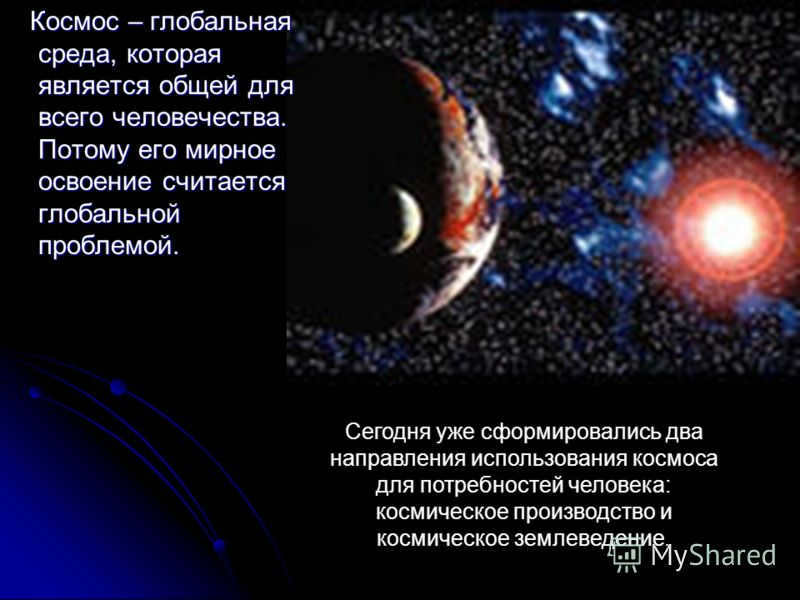
The exploration of space is regarded as a worldwide issue due to the fact that space is a shared environment for all of humanity. It is considered a global problem to ensure that space exploration is conducted in a peaceful manner. Currently, there are two main areas of focus in utilizing space for human needs: space production and space exploration.
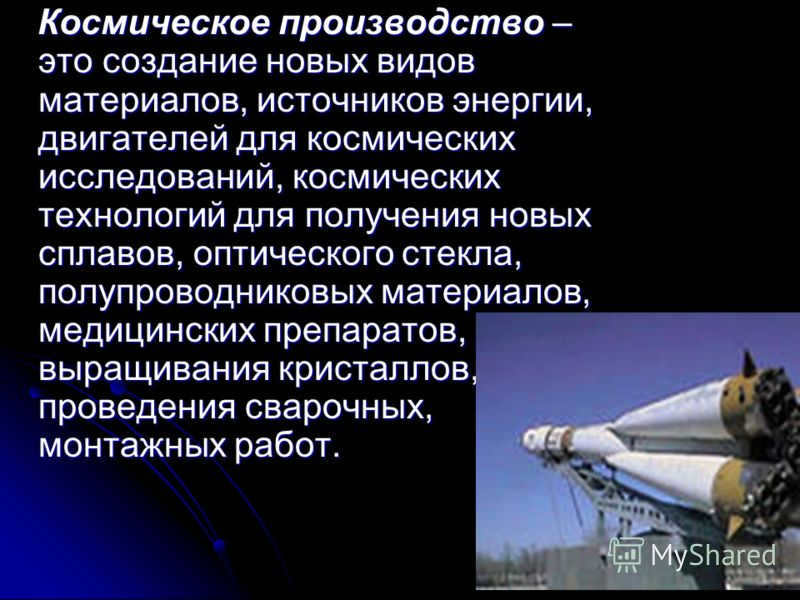
The concept of space production encompasses the development and manufacturing of various materials, energy sources, and engines specifically designed for space exploration. This includes the production of innovative alloys, optical glass, semiconductor materials, medical preparations, crystal growth, welding, and assembly works. The main focus of space production is to create advanced technologies that can be utilized in space research and contribute to the expansion of our knowledge about the universe.
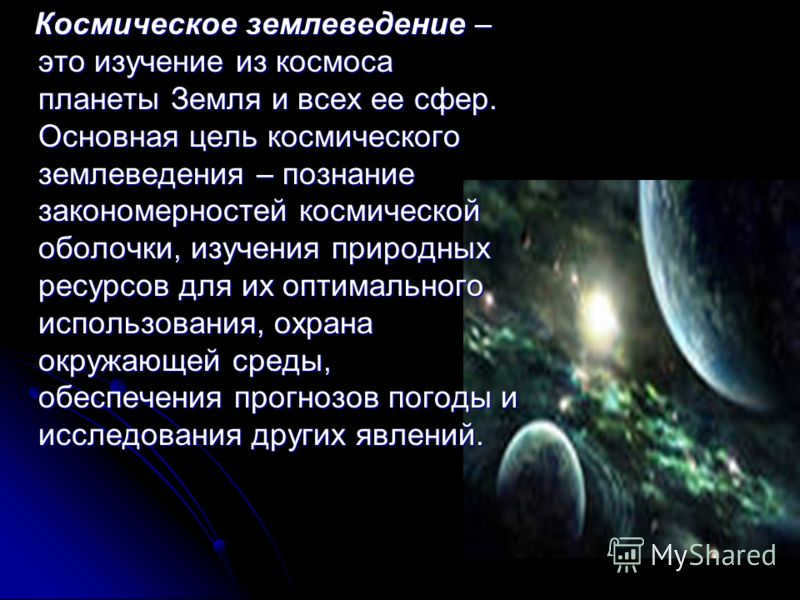
Space earth science, also known as remote sensing, focuses on studying the planet Earth and all its spheres from a space perspective. The primary objective of this field is to understand the patterns and processes of the Earth’s atmosphere, hydrosphere, lithosphere, and biosphere. By examining our planet from space, scientists aim to gain insights into the optimal utilization of natural resources, protect the environment, provide accurate weather forecasts, and investigate various phenomena. With the help of advanced technologies and satellites, space earth science plays a crucial role in advancing our understanding of Earth’s dynamics and promoting sustainable development.
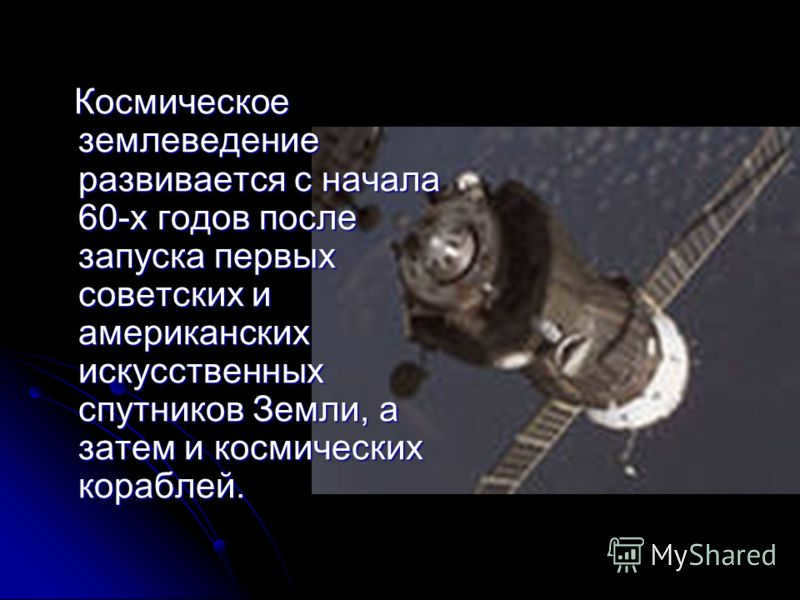
Since the early 1960s, the field of space earth science has been advancing rapidly following the successful launch of the initial Soviet and American artificial Earth satellites, as well as spacecraft. The development of space earth science began in the early 1960s after the successful launch of the initial Soviet and American artificial satellites and subsequent spacecraft.
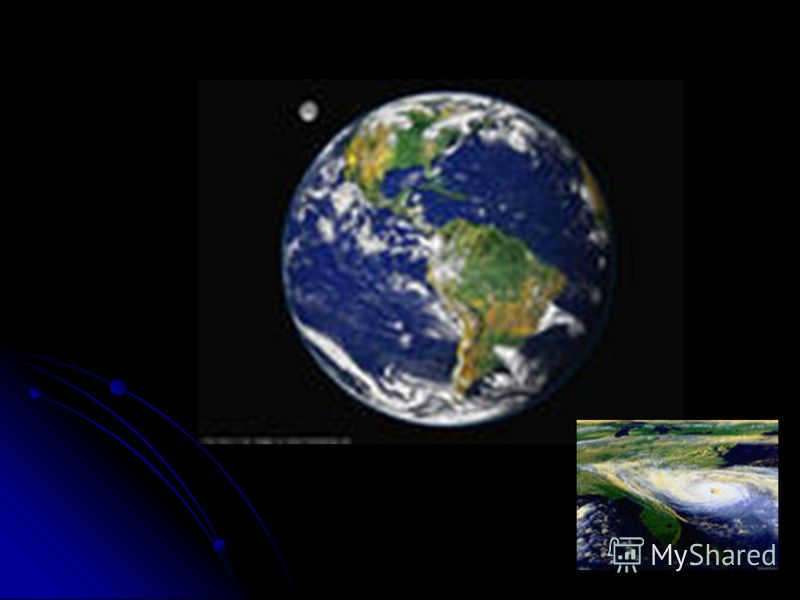
The initial photographs of space were captured in 1961 by German Titovim. Simultaneously, the crew members aboard spacecrafts started visually observing the Earth’s surface. The distinct characteristics of space imagery hold significant value for space earth science. Typically, imaging is conducted from an altitude of 250 – 500 km, with the broad view extending beyond 1,000 km. German Titovim was responsible for the first space images in 1961. Concurrently, spacecraft crews began visually observing the Earth’s surface. The distinct features of space imagery are particularly important for space earth science. Usually, the survey is conducted from an altitude of 250 – 500 km, with the expansive view exceeding 1,000 km.
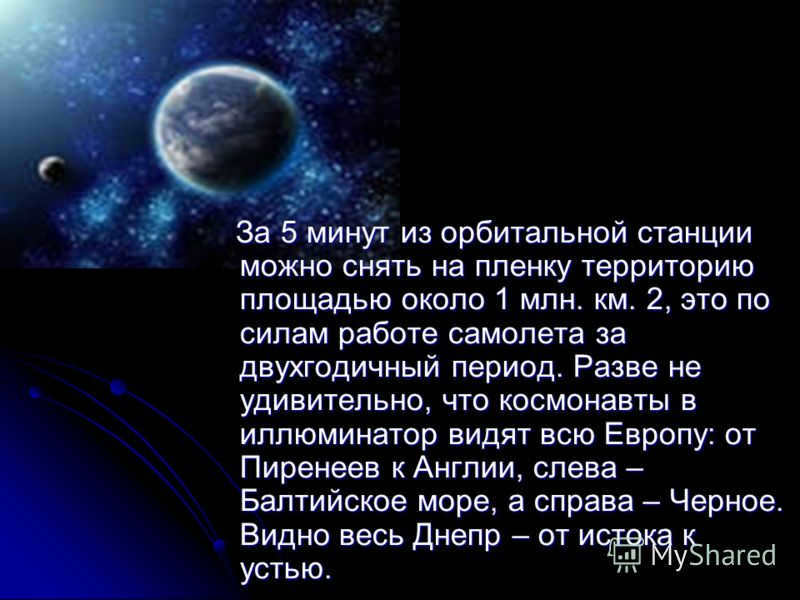
Within a span of 5 minutes, the orbital station has the capability to capture an area equivalent to approximately 1 million square kilometers. This is comparable to the amount of ground covered by an airplane over a two-year period. It is truly remarkable that astronauts are able to witness the entirety of Europe through the window: from the Pyrenees to England, with the Baltic Sea on the left and the Black Sea on the right. Furthermore, they can observe the entire length of the Dnieper River, from its source to its mouth. In just 5 minutes, the orbital station can capture an area of approximately 1 million square kilometers, which is equivalent to the work of an airplane over a two-year period. It’s truly astonishing that astronauts have the opportunity to witness the entire continent of Europe through their porthole: from the Pyrenees to England, with the Baltic Sea on the left and the Black Sea on the right. They can even see the entire course of the Dnieper River, from its origin to its delta.
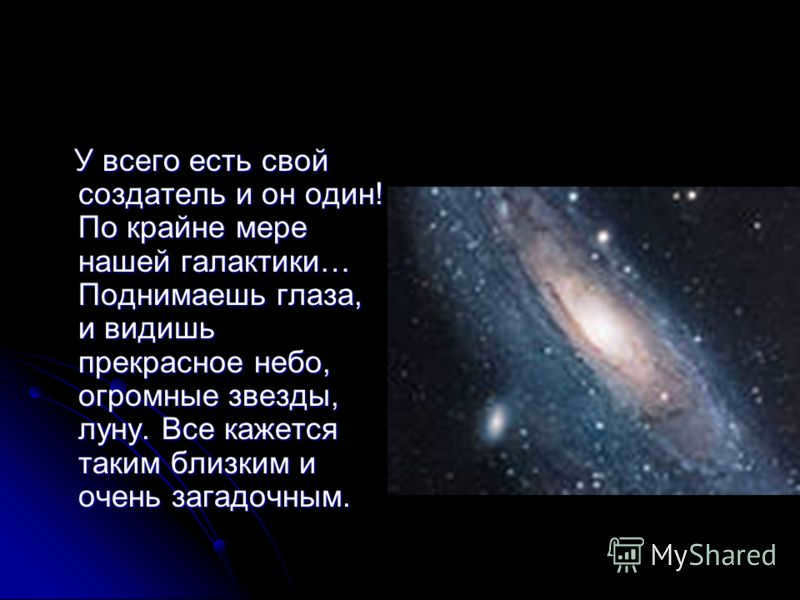
Every single thing in the universe has its own creator and that creator is unique! Well, at least in our galaxy… When you gaze up at the sky, you are mesmerized by the enchanting sight of vast stars, the mesmerizing moon, and the sheer proximity of it all. Every single thing in the universe has its own creator and that creator is one of a kind! Well, at least in our galaxy… When you look up at the sky, you are captivated by the awe-inspiring view of immense stars, the captivating moon, and the undeniable sense of closeness and mystery.
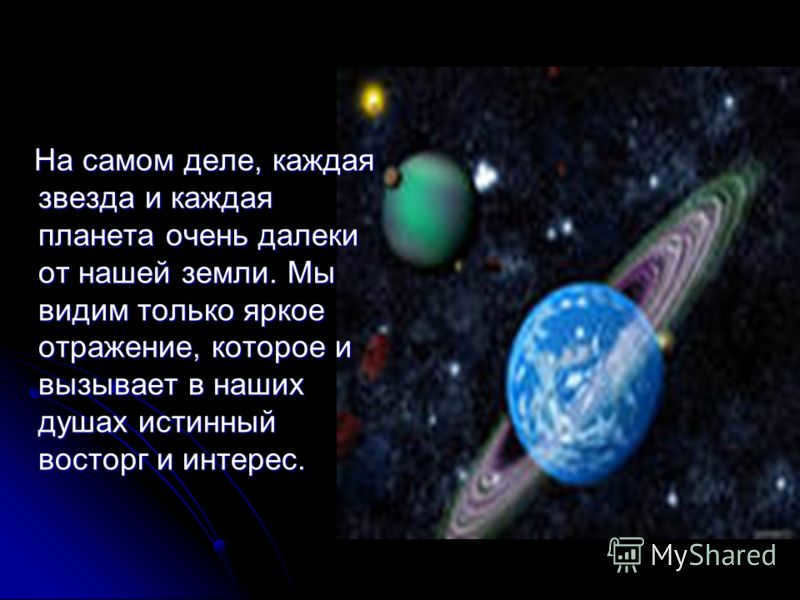
Actually, each star and planet is located at a considerable distance from our planet. We only perceive a brilliant reflection, which brings genuine joy and fascination to our inner selves. In reality, every star and planet is situated far away from our earth. We merely witness a dazzling reflection that evokes authentic delight and captivation within us.
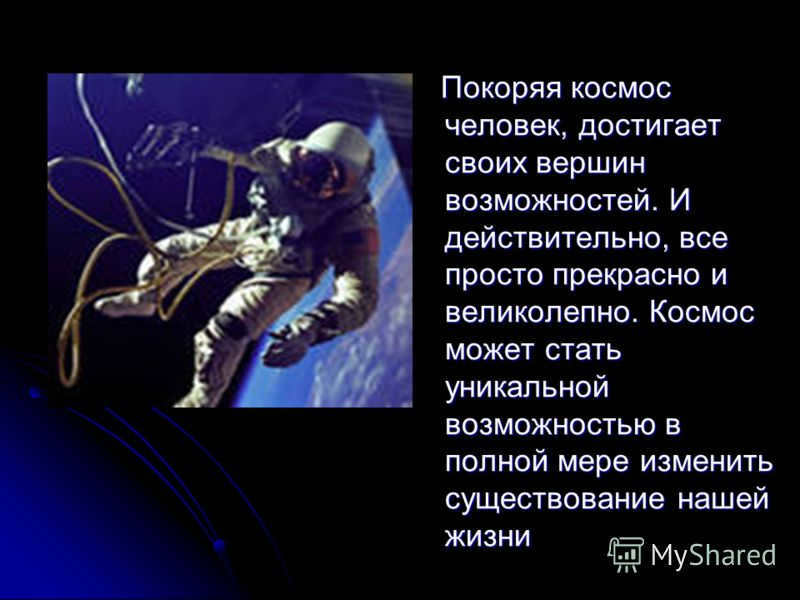
By exploring the vastness of the cosmos, humanity has the chance to unlock endless possibilities. It is truly awe-inspiring and breathtaking. The vastness of space provides a rare opportunity to revolutionize our way of life. As we conquer the cosmos, we reach the pinnacle of our potential. The beauty and magnificence of it all is simply unparalleled. Space presents us with a unique chance to completely transform our existence.
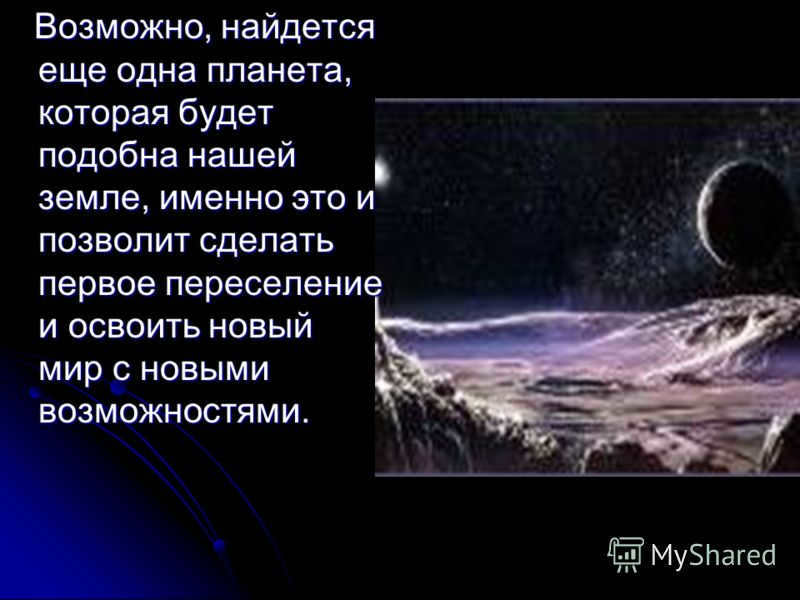
Maybe there will be a different planet that resembles our planet, which will enable us to establish the initial colonization and discover a fresh realm with unique opportunities. Maybe there will be another planet that closely resembles our earth, and this is what will enable us to initiate the first resettlement and cultivate a novel world with innovative possibilities.
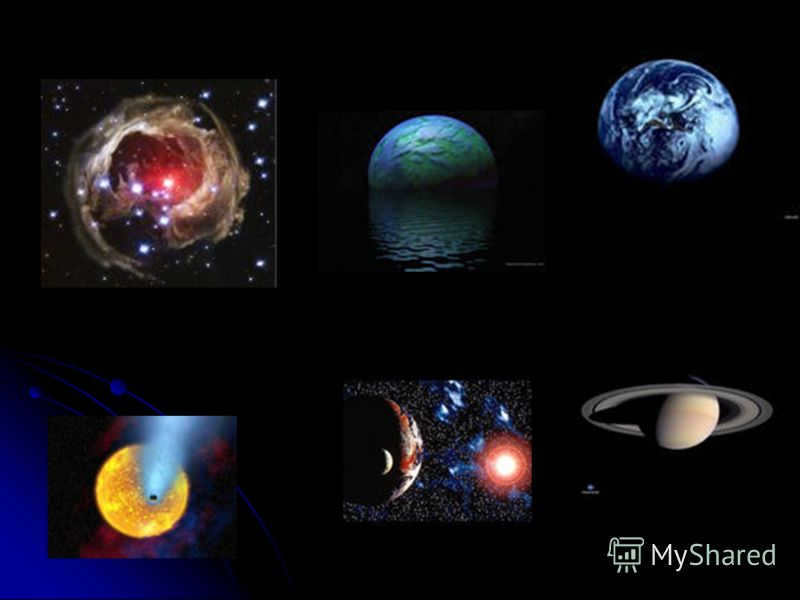
There is a silent battle for territory between two significant nations, and every leader recognizes that the exploration of outer space holds the key to the future, which is undoubtedly worth delving into.
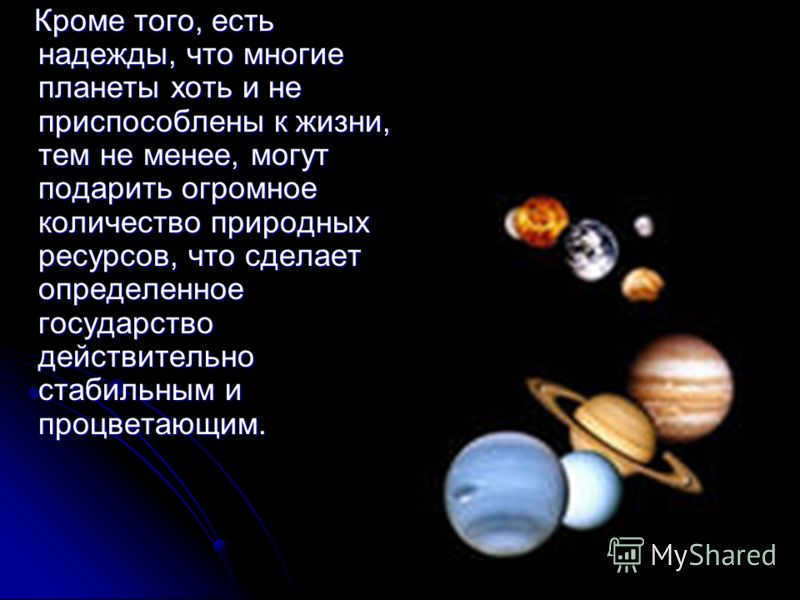
Moreover, there is optimism that numerous celestial bodies, while unsuitable for habitation, have the potential to yield a vast quantity of valuable resources, thereby providing a particular nation with long-term stability and prosperity. Furthermore, it is anticipated that a multitude of planets, while not conducive to supporting life, possess an abundance of natural resources that could greatly enhance the overall well-being and economic standing of a specific country.
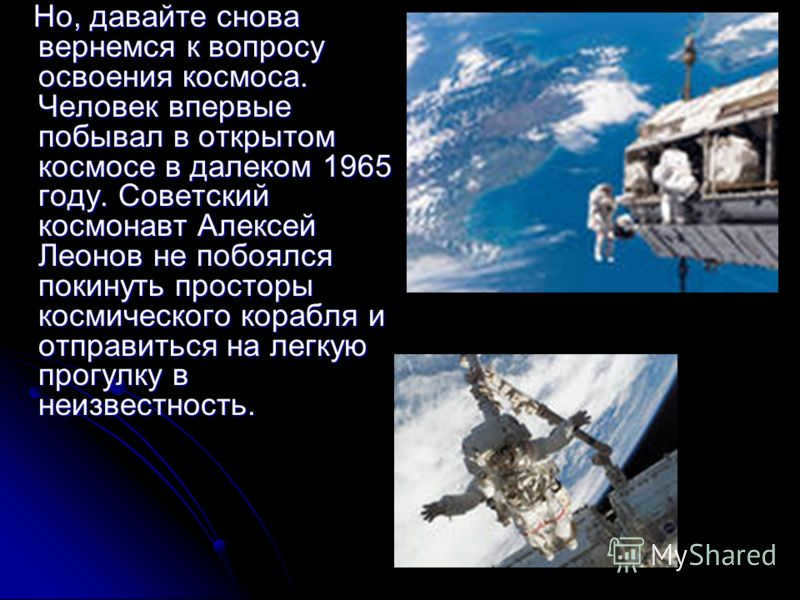
However, let’s once again consider the topic of space exploration. It was in the year 1965 that humanity first ventured into the vastness of outer space. A fearless Soviet cosmonaut named Alexei Leonov bravely stepped out of the spaceship and embarked on a leisurely stroll into the great unknown. Nevertheless, let’s revisit the subject of space exploration. It was in the distant year of 1965 that mankind first set foot in outer space. Alexei Leonov, a courageous Soviet cosmonaut, fearlessly departed from the confines of the spacecraft and embarked on an effortless promenade into uncharted territory.
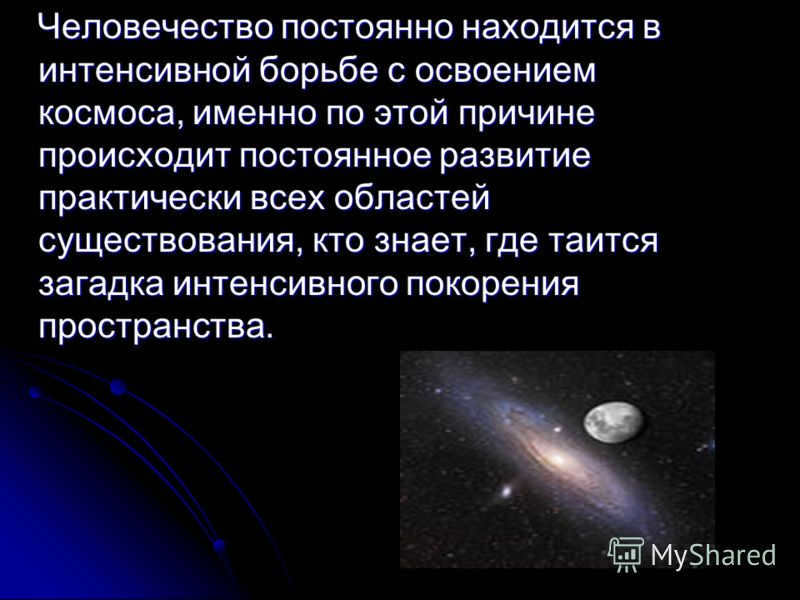
Humanity is engaged in a perpetual battle to explore the vastness of space, leading to advancements in every aspect of our existence. The mystery of space conquest holds endless possibilities, and its exploration fuels our continuous growth and development.
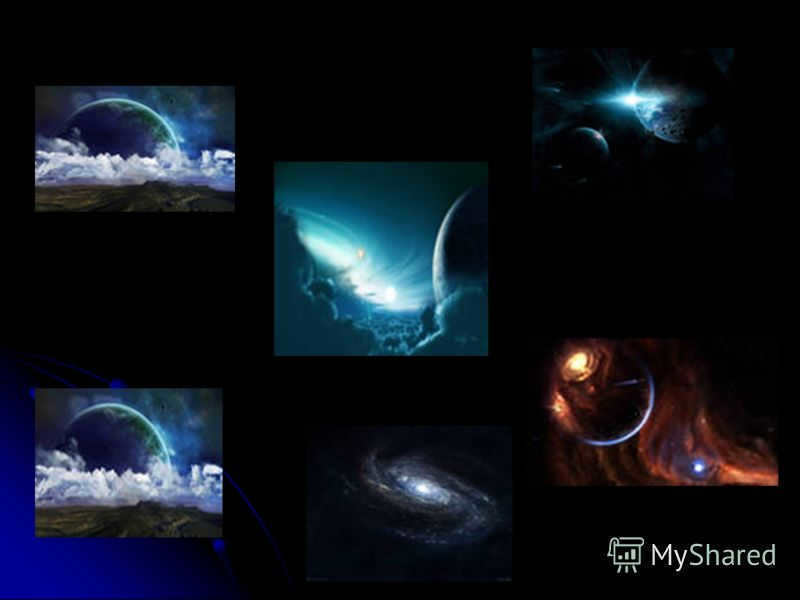

An astronaut’s physical health must be excellent in order to withstand the numerous negative and potentially harmful factors experienced during spaceflight. These factors are unfamiliar and can have detrimental effects on the body. Therefore, it is imperative for astronauts to maintain optimal physical health.
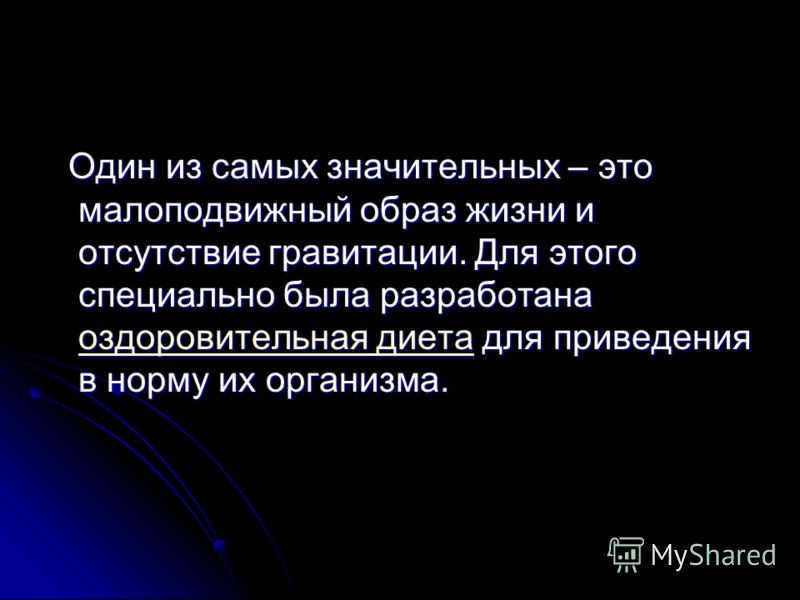
One of the major factors contributing to this issue is the inactive way of life and absence of gravitational force. In order to combat these challenges, a specialized wellness diet has been formulated to restore their bodies to their normal state. Addressing the sedentary lifestyle and lack of gravity, the wellness diet plays a crucial role in normalizing their physical condition. wellness diet wellness diet wellness diet

It can assist in shedding extra pounds even for individuals who never intended to pursue a career as an astronaut, but rather considered consulting a healthcare professional for guidance in order to maintain their well-being and avoid stress. And let the following statement be emphasized: “Prioritize your health, just like astronauts do!” It can assist in shedding extra pounds even for individuals who never intended to pursue a career as an astronaut, but rather considered consulting a healthcare professional for guidance in order to maintain their well-being and avoid stress. And let the following statement be emphasized: “Prioritize your health, just like astronauts do!”

It is not advisable to have a strong preference for uninformed diets, as this often leads to a decline in health and various ailments. There are specific guidelines for diets for both males and females. The diets for men and “female” diets primarily vary in terms of caloric intake. It is not advisable to have a strong preference for uninformed diets, as this often leads to a decline in health and various ailments. There are specific guidelines for diets for both males and females. The diets for men and “female” diets primarily vary in terms of caloric intake.

Every year in Russia, April 12 commemorates the inaugural human space flight. Additionally, schools incorporate lessons on the cosmos, space objects, aircraft, stars, and the sky into their curriculum for subjects like the natural world, history, and astronomy.
In this section, we have compiled PowerPoint presentation templates focused on Space, space exploration, planets, the universe, stars, and celestial bodies. You can download these templates to your computer and utilize them to create educational presentations.
Typically, presentations about the Cosmos feature a dark blue background with star imagery. However, when designing educational presentations, it is important to keep two rules in mind:
- Avoid using dark text on a dark background, as it will make the text unreadable. Instead, consider using a transparent “backing” on the background;
- There are numerous classrooms in schools that lack adequately shaded windows and are not ideal for clear image visibility.
Therefore, it is important to consider the backdrop of your Space presentation, ensuring it is not excessively dim and that the text displayed contrasts well. Additionally, it is crucial for teachers to prioritize the preservation of students’ eyesight.
Background for Space Presentation
PowerPoint offers teachers numerous opportunities to conduct engaging, visually appealing, and informative lessons. The slides can be used to incorporate illustrative materials, video clips, and experiment recordings that may be challenging to conduct in a traditional school laboratory. Additionally, graphs, charts, and tables can be easily displayed on slides, making it convenient for presenting data. Moreover, PowerPoint presentations are highly beneficial for quizzes, particularly when animation effects are utilized.
However, the only drawback is the time required to create a presentation, with a significant portion of it being dedicated to designing the layout. It is essential for the layout’s design and style to align with the lesson’s theme or extracurricular activity, which adds further complexity to the process.
However, these challenges can easily be overcome by downloading a complimentary presentation template from our website. For instance, in this section, you have the option to select a visually appealing template for a lesson or event centered around the topic of space. Choose a layout and start creating!
Svetlana Obushenko
Presentation “What is Space?”
Purpose: To enhance children’s understanding of space
Tasks: To broaden children’s comprehension of the vastness of the cosmos.
Expand elementary concepts regarding space;
To share intriguing facts and events linked to space;
To instill patriotic sentiments and love for the homeland;
To enrich vocabulary with words related to the subject;
To nurture curiosity, logical thinking, imagination, and fantasy;
Throughout the ages, humanity has been captivated by the enigmatic and puzzling nature of the universe. Countless questions about the cosmos have perplexed mankind, leaving them without answers. In an attempt to unravel the secrets of the cosmos, people have gradually amassed knowledge about it.
What is your understanding of the term “space”? (responses from children)
(1-3 slides) Our planet, encompassed by a vast expanse, is surrounded by the boundless depths of space. This expansive realm is home to celestial entities, such as the sun, stars, planets, and meteorites.
(slide 4-6) Initially, the study of outer space was aided by artificial satellites launched into orbit. Currently, there are approximately 300 satellites orbiting the Earth, serving various purposes such as global communication, broadcasting television signals, and providing weather information. These satellites also assist in navigation by transmitting signals to guide ships. Furthermore, they play a crucial role in the exploration of celestial bodies, including the Earth, the sun, planets, and stars.
(7-10 slide) Following the advent of satellites, spacecraft have been launched into the vastness of outer space. Before the first manned spaceflight, numerous missions were conducted to explore the unknown cosmos. On August 19, 1960, the dogs Belka and Strelka embarked on a successful flight and safely returned to Earth, paving the way for human space exploration.
(11-13 slide) Following successful animal experiments, humans began to be trained for space travel in order to conduct flights into outer space. This led to the emergence of a new profession – astronaut. An astronaut is an individual who undertakes space flights and carries out in-flight testing and experimentation with space technology.
(14-15 slide) The first person to ever journey into outer space was Yuri Alexeyevich Gagarin. His name is renowned worldwide. On April 12, 1961, the pilot and cosmonaut of the USSR, Yu. A. Gagarin, made history by embarking on the world’s inaugural space flight aboard the spacecraft "Vostok 1". The spacecraft completed one full orbit around the Earth in a span of 108 minutes.
(16 slide) Valentina Tereshkova holds the distinction of being the first female cosmonaut.
(17-19 slide) Alexei Leonov – the first person to exit a spaceship in outer space
(20 slide.) Neil Armstrong became the initial human to step foot on the lunar surface
(21 slide) Sergei Pavlovich Korolev – guided humanity to the celestial bodies – produced a rocket.
(22-23 slide) A rocket launcher places into orbit into orbit. which is attached at the top of the rocket. And beneath that are the stages, which have their own engines and fuel supply. A spaceship serves as both a living space and a scientific laboratory. It’s where astronauts reside and carry out their work astronauts reside and work within it.
When the rocket reaches the appropriate altitude and the final stage separates, the spaceship the spacecraft continues on its own. It becomes an Earth satellite.
In the main compartment, the astronauts are launched from Earth. From here, they control the ship and communicate with Earth via radio. This is the only part of the ship that returns to Earth.
From their cockpit, the astronauts enter the orbital compartment through the hatchway.
Here, they conduct scientific experiments, sleep, and play sports.
(Slides 26-29) In space, objects cannot fall and break. Together with the astronauts, they are "floating" inside the spaceship. That’s because in space ships, there is a state of weightlessness, in which a person and objects around him become lighter than a piece of fluff.
(Slides 30-31) In the absence of gravity, food undergoes significant changes compared to its state on Earth. It is crucial to ensure that no crumbs or food droplets are left behind, as they can interfere with the functioning of instruments and potentially cause damage. To address this issue, food aboard spaceships is stored in tubes, similar to toothpaste tubes but larger in size. The food is then squeezed out from these tubes.
(Slide 32) The Mission Control Center serves as the hub on Earth for the control and management of satellites, spacecraft, and interplanetary stations.
(Slide 33) Upon completion of their tasks, astronauts make their return journey to Earth. Unnecessary compartments are detached and burn up in the atmosphere. As the spacecraft approaches Earth, a parachute is deployed to soften the impact upon landing.
Now, let’s take a break and play a game called «Astronaut ».
One-two, behold a spacecraft. (children raise their hands in the air)
Three-four, about to launch. (hands spread apart)
♪ To soar towards the sun ♪ (hands circle)
Astronauts require a year . (hands on cheeks, shakes head)
♪ But we have no fear of the journey ♪ (arms out to the sides, body tilts to the left and right)
Each one of us is an athlete (arms bend at elbows)
♪ Flying above the ground ♪ (arms out to the sides)
Let’s greet her. (hands up in the air and waving)
♪ Here we are in outer space ! Can you experience the weightlessness? You’re as light as a feather.
And now we will test who among you was the most observant.
Leisure activity for children in the preparatory group: “Understanding the difference between good and bad”. Purpose: To instill in children an understanding of the concept of good and bad actions. Objectives: – To introduce children to different facial expressions that convey emotions.
Activity plan for children in the senior group: “Exploring the world of wild animals in our forests”. Purpose: To enhance and organize children’s knowledge about the various wild animals that inhabit our forests. Objectives: Educational: 1. Engage children in exercises that involve critical thinking and problem-solving.
Lesson objective: Engaging in a discussion with children about the concept of good and bad actions, in order to enhance their ability to engage in dialogues. Lesson objectives: Create an environment that fosters.





